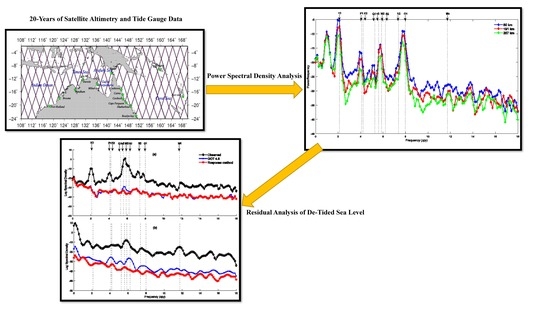Spectral Analysis of Satellite Altimeter and Tide Gauge Data around the Northern Australian Coast
Abstract
1. Introduction
2. Data and Study Region
3. Method
4. Results
4.1. Spectral Analysis of Satellite Altimetry Data
4.2. Spectral Analysis of Tide Gauge Data
4.3. Residual Analysis of De-Tided Sea Level
5. Discussion
6. Summary
Author Contributions
Funding
Acknowledgments
Conflicts of Interest
Appendix A
Appendix A.1. Response Method
References
- Koblinsky, C.J.; Ray, R.D.; Beckley, B.D.; Bremmer, A.; Tsaoussi, L.S.; Wang, Y.M. NASA Ocean Altimeter Pathfinder Project. Report 2; Data Set Validation. 1999. Available online: https://ntrs.nasa.gov/search.jsp?R=19990058149 (accessed on 27 December 2019).
- Cherniawsky, J.Y.; Foreman, M.G.G.; Crawford, W.R.; Henry, R.F. Ocean tides from TOPEX/poseidon sea level data. J. Atmos. Ocean. Technol. 2001, 18, 649–664. [Google Scholar] [CrossRef]
- Gharineiat, Z.; Deng, X. Description and assessment of regional sea-level trends and variability from altimetry and tide gauges at the northern Australian coast. Adv. Space Res. 2018, 61, 2540–2554. [Google Scholar] [CrossRef]
- Erol, S. Time frequency analyses of tide-gauge sensors data. Sensors 2011, 11, 3939–3961. [Google Scholar] [CrossRef] [PubMed]
- Manzano-Agugliaro, F.; Corchete, V.; Lastra, X.B. Spectral analysis of tide waves in the strait of gibraltar. Sci. Res. Essays 2011, 6, 453–462. [Google Scholar]
- Ozsoy, O.; Haigh, I.D.; Wadey, M.P.; Nicholls, R.J.; Wells, N.C. High-frequency sea level variations and implications for coastal flooding: A case study of the solent, UK. Cont. Shelf Res. 2016, 122, 1–13. [Google Scholar] [CrossRef]
- Pirooznia, M.; Emadi, S.R.; Najafi Alamdari, M. Satellite altimetry and coastal tide gauges and tide modeling in the coast of caspian sea. Open J. Mar. Sci. 2016, 6, 258–269. [Google Scholar] [CrossRef]
- Allen, S.C.R.; Greenslade, D.J.M. A Spectral Climatology of Australian and South-West Pacific Tide Gauges; CAWCR Technical Report, No. 011; Centre for Australian Weather and Climate Research, a Partnership between the Bureau of Meteorology and CSIRO: Melbourne, Australia, 2009. [Google Scholar]
- Gharineiat, Z.; Deng, X. Application of the multi-adaptive regression splines to integrate sea level data from altimetry and tide gauges for monitoring extreme sea level events. Mar. Geod. 2015, 38, 261–276. [Google Scholar] [CrossRef]
- Carrère, L.; Lyard, F. Modeling the barotropic response of the global ocean to atmospheric wind and pressure forcing-comparisons with observations. Geophys. Res. Lett. 2003, 30, 1275. [Google Scholar] [CrossRef]
- Andersen, O.B.; Knudsen, P.; Stenseng, L. The DTU13 MSS (mean sea surface) and MDT (mean dynamic topography) from 21 years of satellite altimetry. Int. Assoc. Geod. Symp. 2015, 144, 1–10. [Google Scholar]
- Dorandeu, J.; Le Traon, P.Y. Effects of global mean atmospheric pressure variations on mean sea level changes from TOPEX/Poseidon. J. Atmosp. Ocean. Technol. 1999, 16, 1279–1283. [Google Scholar] [CrossRef]
- Vaniček, P. Approximate spectral analysis by least squares fit. Astrophys. Space Sci. 1969, 4, 387–391. [Google Scholar] [CrossRef]
- Trupin, A.; Wahr, J. Spectroscopic analysis of global tide gauge sea level data. Geophys. J. Int. 1990, 100, 441–453. [Google Scholar] [CrossRef]
- Welch, P. The use of fast fourier transform for the estimation of power spectra: A method based on time averaging over short, modified periodograms. IEEE Trans. Audio Electroacoust. 1967, 15, 70–73. [Google Scholar] [CrossRef]
- Allen, J. Short-term spectral analysis, and modification by discrete fourier transform. IEEE Trans. Acoust. Speech Signal Process. 1977, 25, 235–238. [Google Scholar] [CrossRef]
- Nikolaidis, R. Observation of Geodetic and Seismic Deformation with the Global Positioning System. Ph.D. Thesis, University of California, San Diego, CA, USA, January 2002. [Google Scholar]
- Pugh, D.; Woodworth, P. Sea-Level Science: Understanding Tides, Surges, Tsunamis and Mean Sea-Level Changes; Cambridge University Press: Cambridge, UK, 2014. [Google Scholar]
- Andersen, O.B. Shallow water tides in the northwest European shelf region from topex/poseidon altimetry. J. Geophys. Res. Oceans 1999, 104, 7729–7741. [Google Scholar] [CrossRef]
- Wilson, B. The Biogeography of the Australian North West Shelf: Environmental Change and Life’s Response; Elsevier: Boston, MA, USA, 2013. [Google Scholar]
- Baker, C.; Potter, A.; Tran, M.; Heap, A.D. Geomorphology and sedimentology of the northwest marine region of australia; Geoscience Australia: Canberra, Australia, 2008. [Google Scholar]
- Chivas, A.R.; García, A.; Van Der Kaars, S.; Couapel, M.J.; Holt, S.; Reeves, J.M.; Wheeler, D.J.; Pearson, G.; Switzer, A.D.; Banerjee, D.; et al. Sea-level and environmental changes since the last interglacial in the gulf of carpentaria, Australia: An overview. Quat. Int. 2001, 83, 19–46. [Google Scholar] [CrossRef]
- Wolanski, E.; Lambrechts, J.; Thomas, C.; Deleersnijder, E. The net water circulation through Torres strait. Cont. Shelf Res. 2013, 64, 66–74. [Google Scholar] [CrossRef]
- Mathews, E.J.; Heap, A.D.; Woods, M. Inter-reefal seabed sediments and geomorphology of the great barrier reef, a spatial analysis. Geosci. Aust. 2007, 9, 140. [Google Scholar]
- Fielding, C.R.; Trueman, J.D.; Dickens, G.R.; Page, M. Anatomy of the buried burdekin river channel across the great barrier reef shelf: How does a major river operate on a tropical mixed siliciclastic/carbonate margin during sea level lowstand? Sediment. Geol. 2003, 157, 291–301. [Google Scholar] [CrossRef][Green Version]
- Munk, W.H.; Cartwright, D.E. Tidal spectroscopy and prediction, philosophical transactions for the royal society of london. Ser. Math. Phys. Sci. 1966, 259, 533–581. [Google Scholar] [CrossRef]
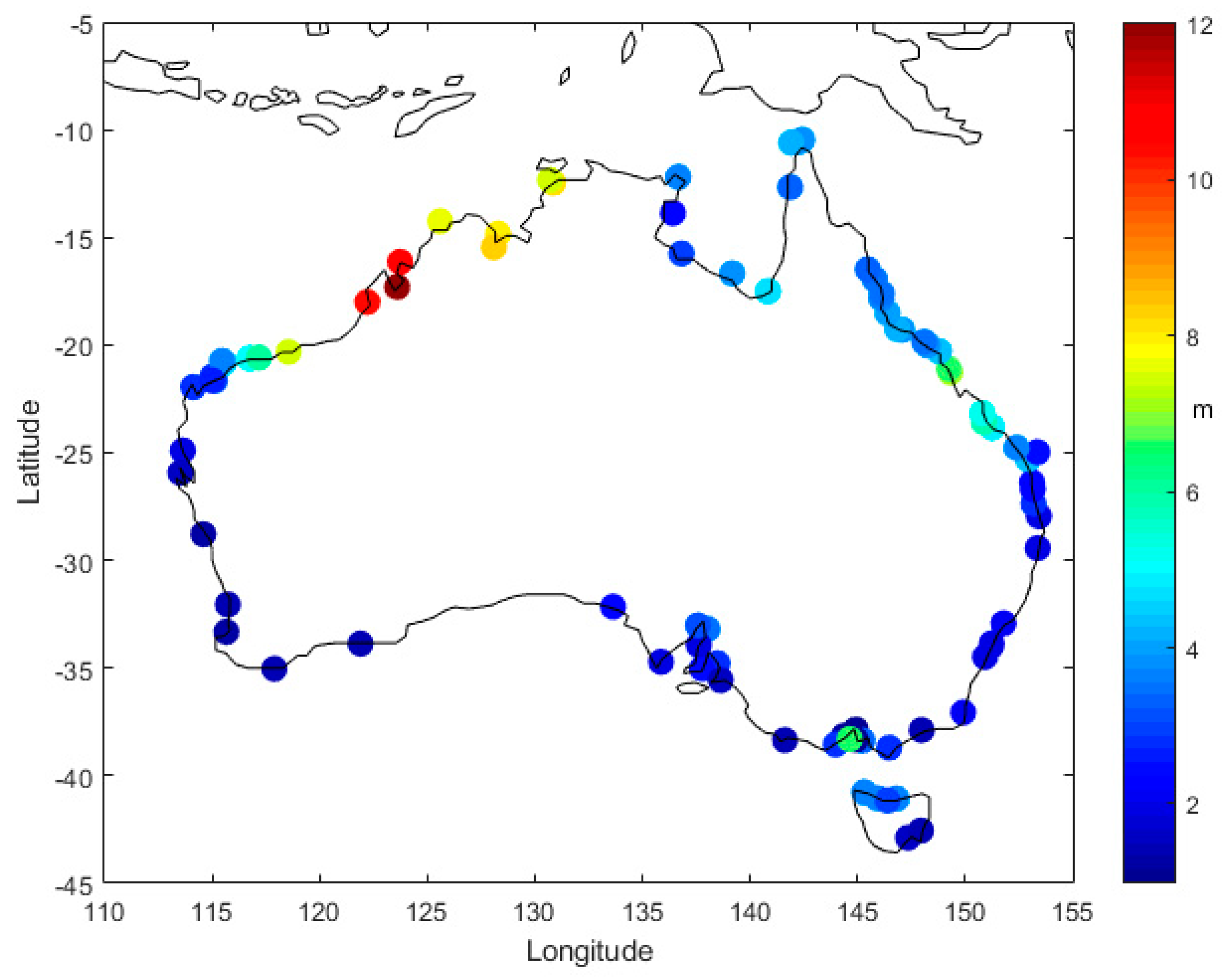
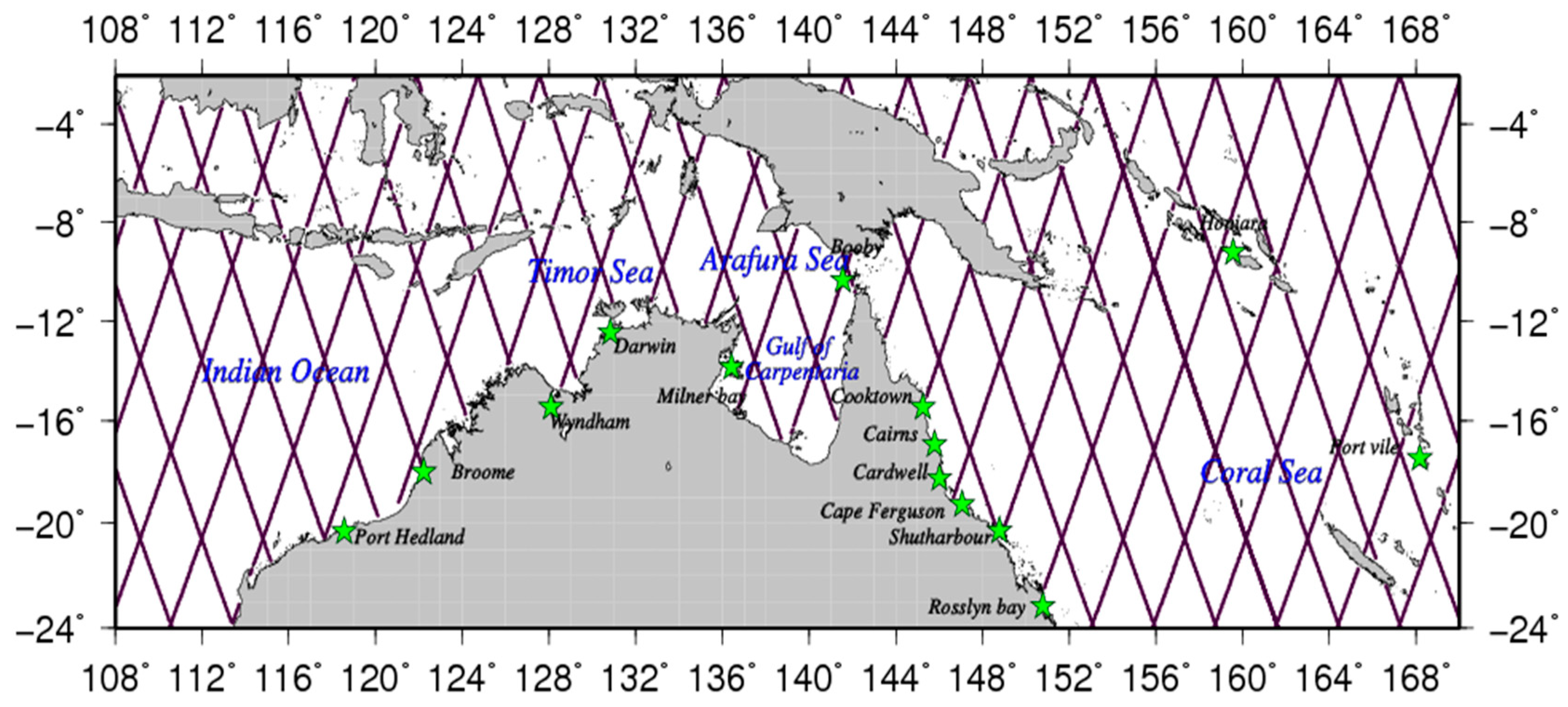
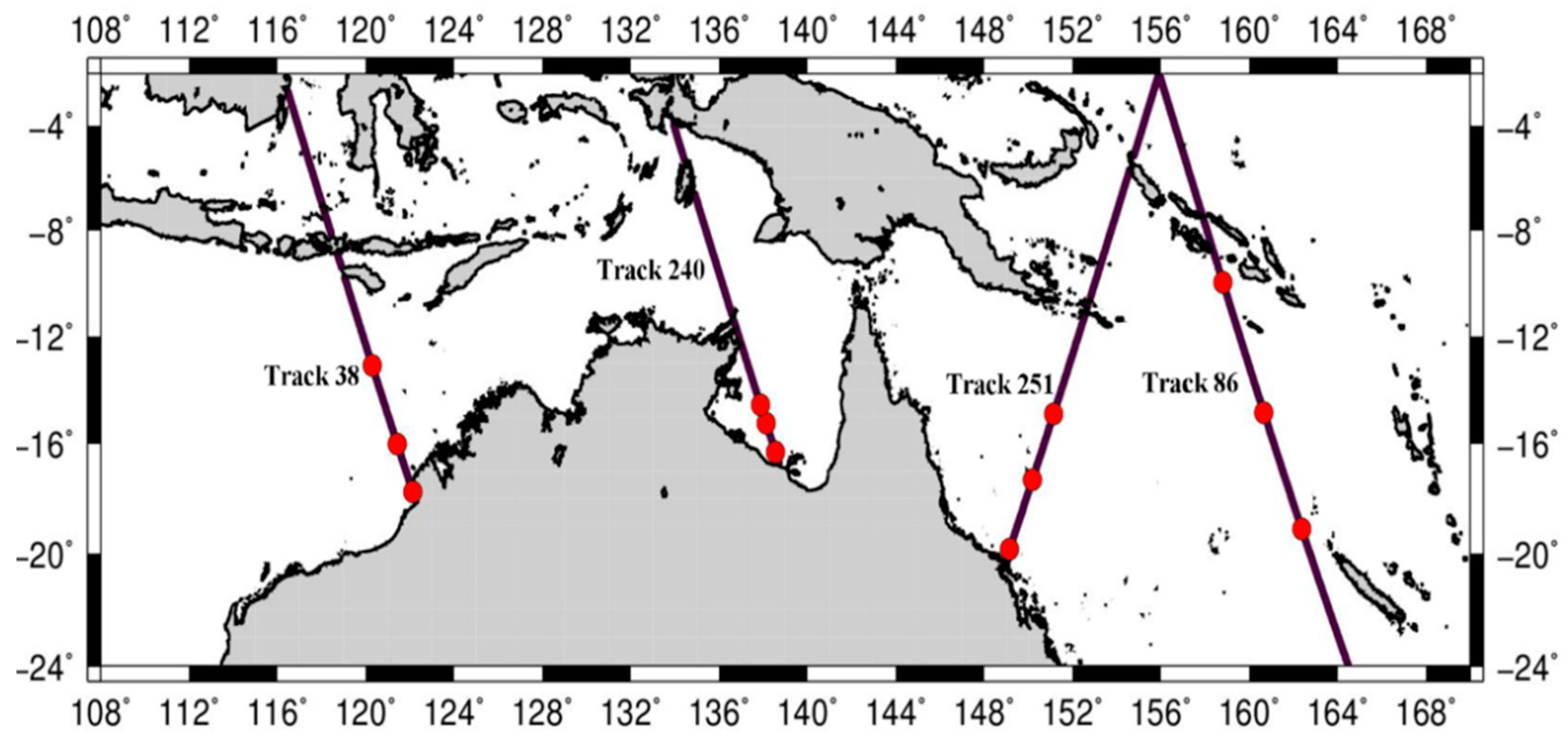
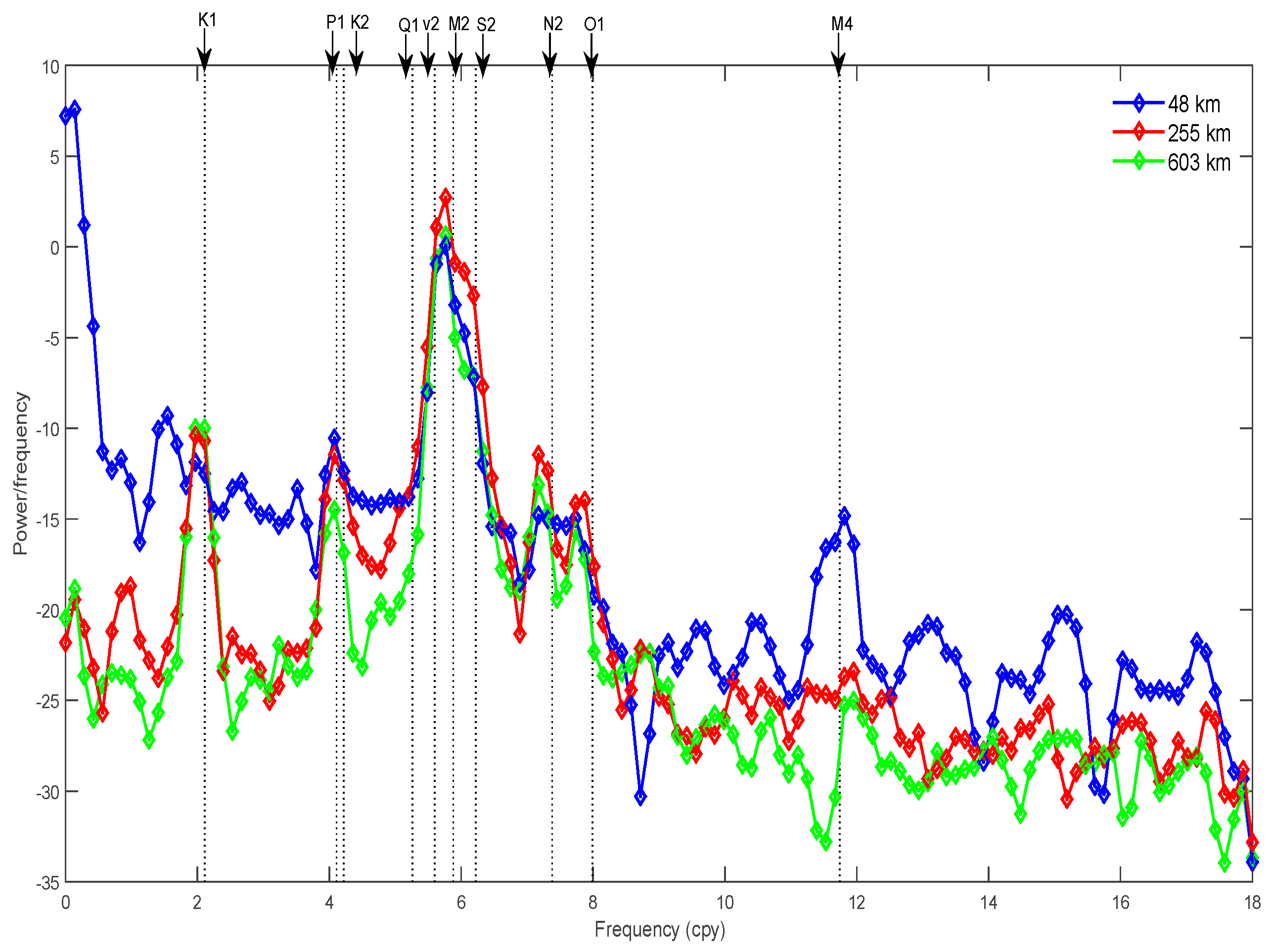
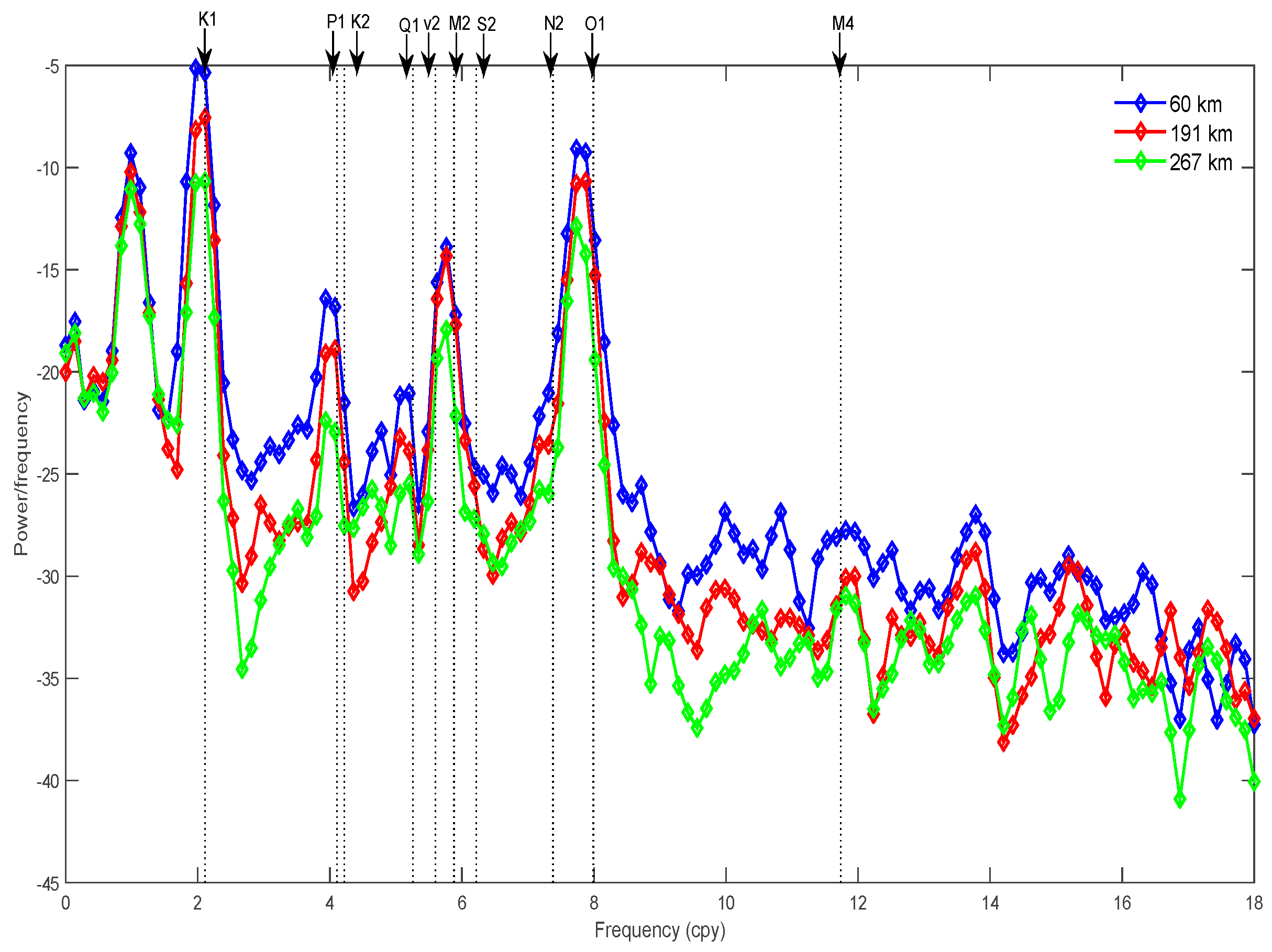
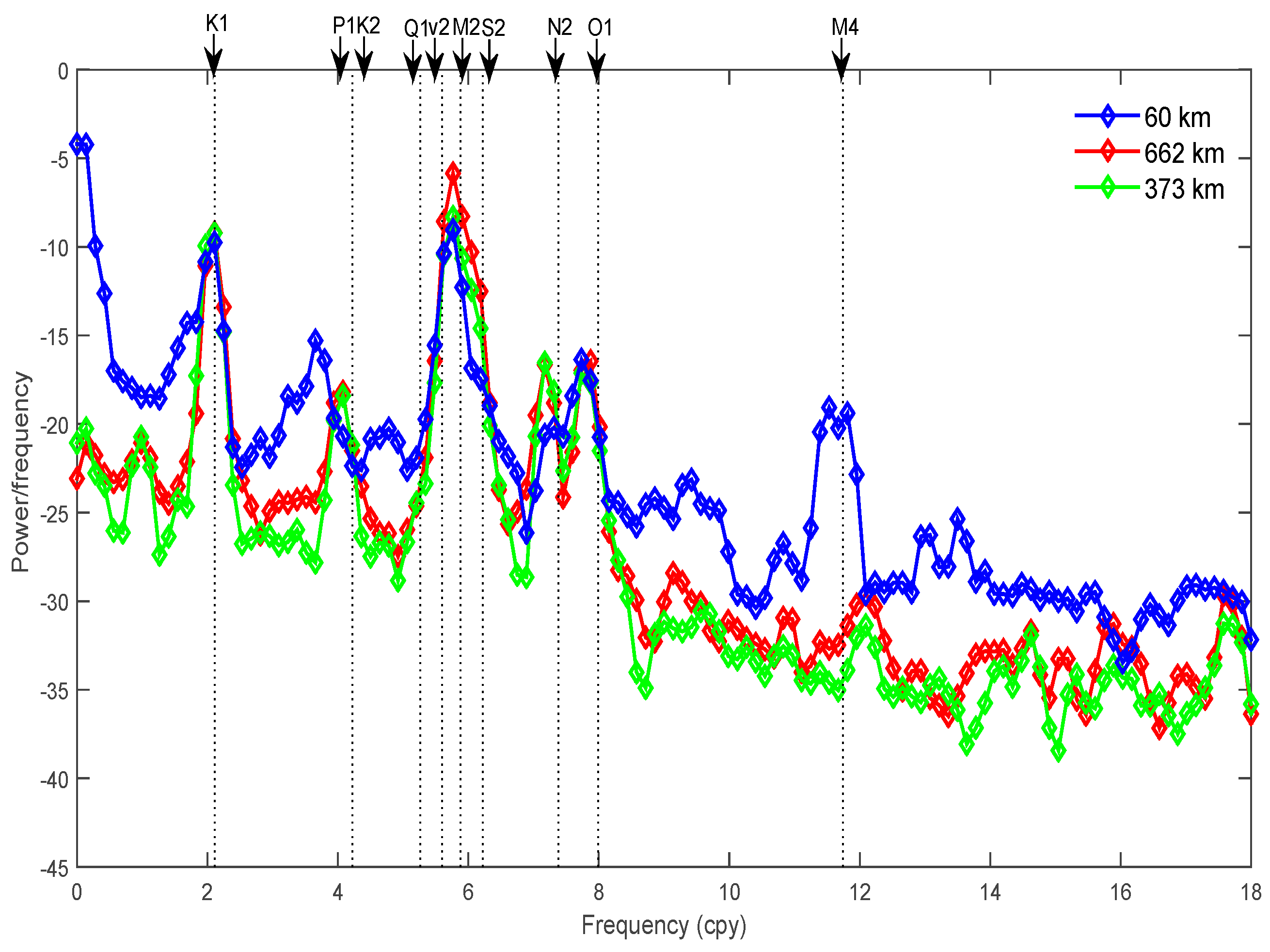
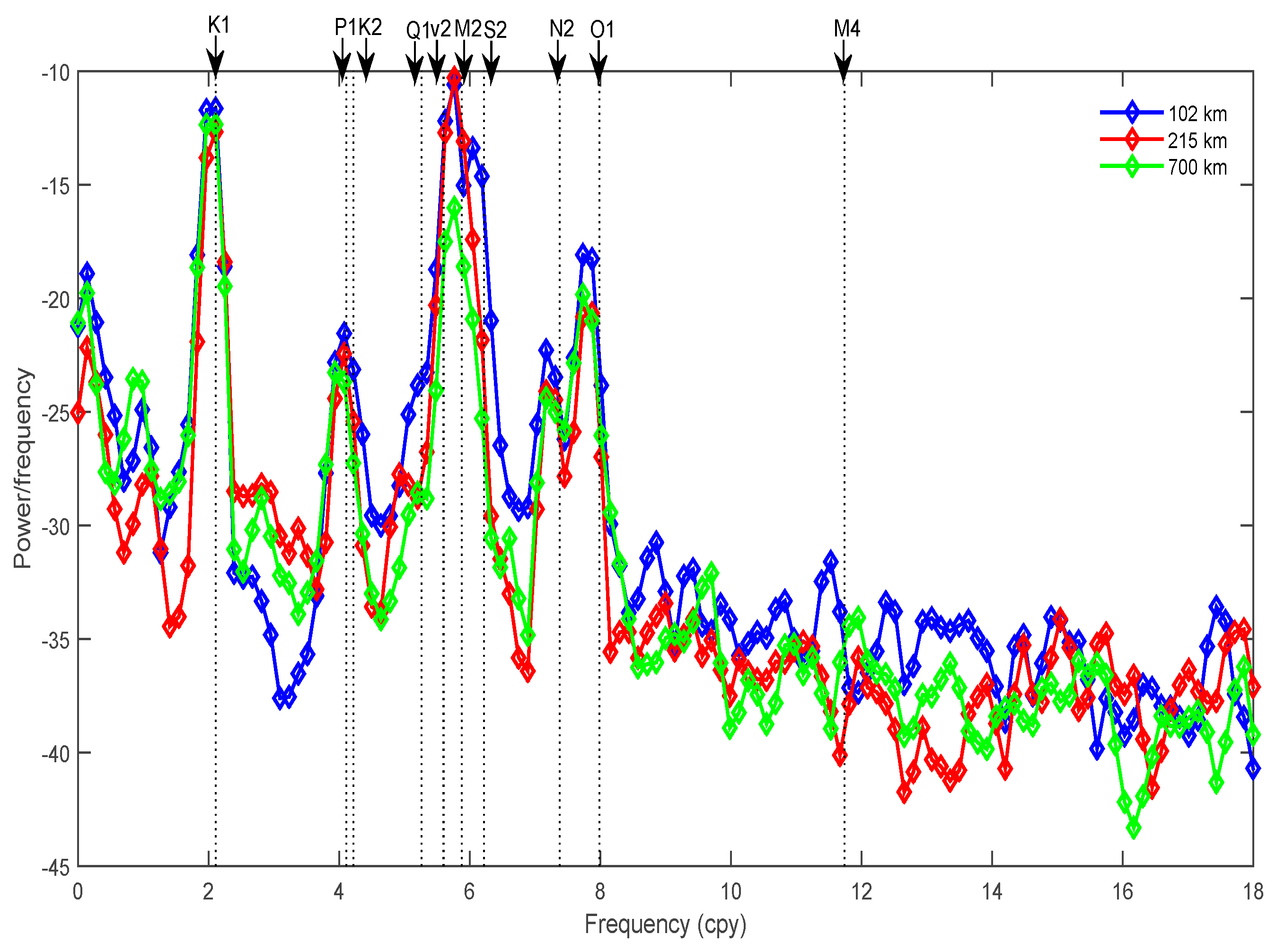
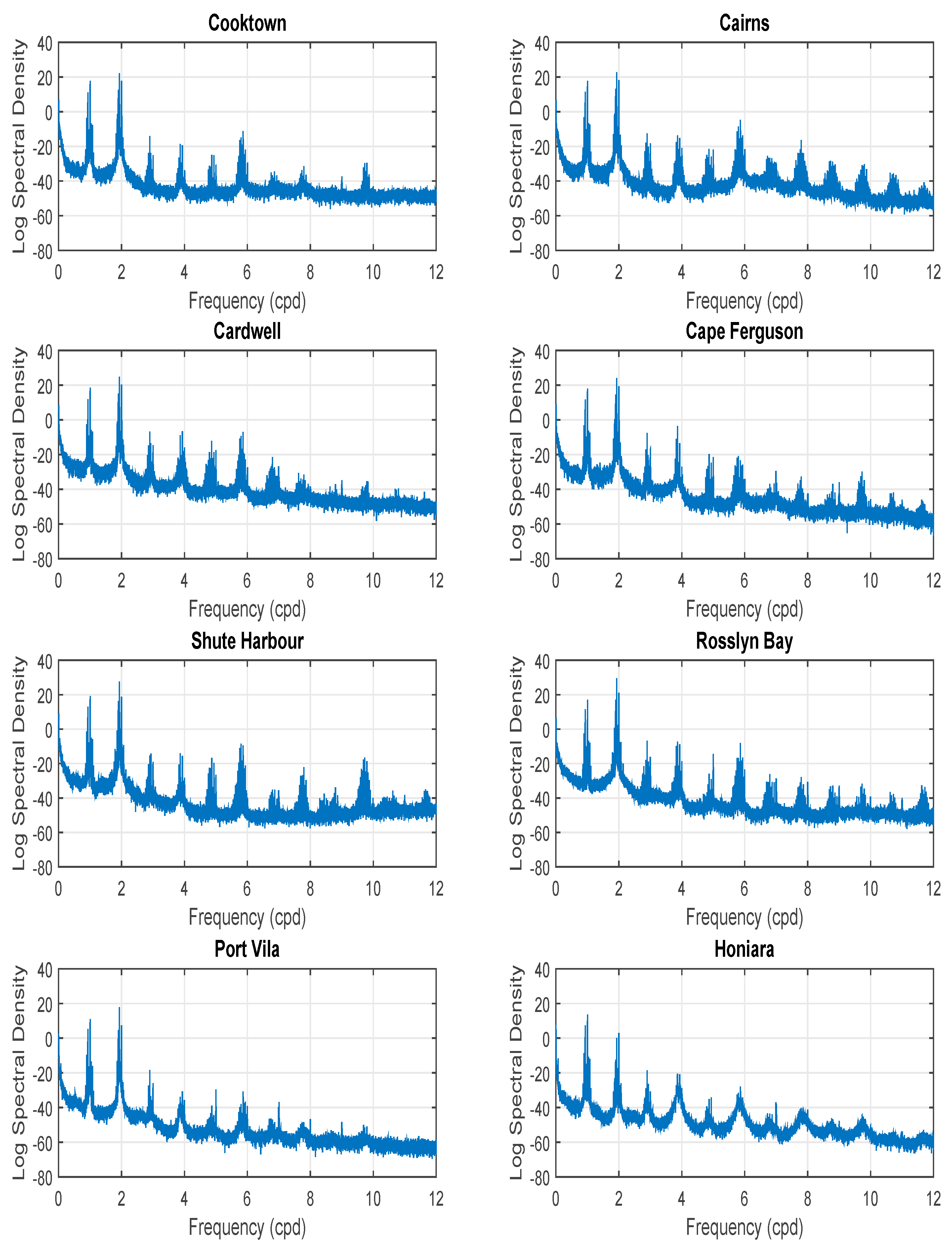
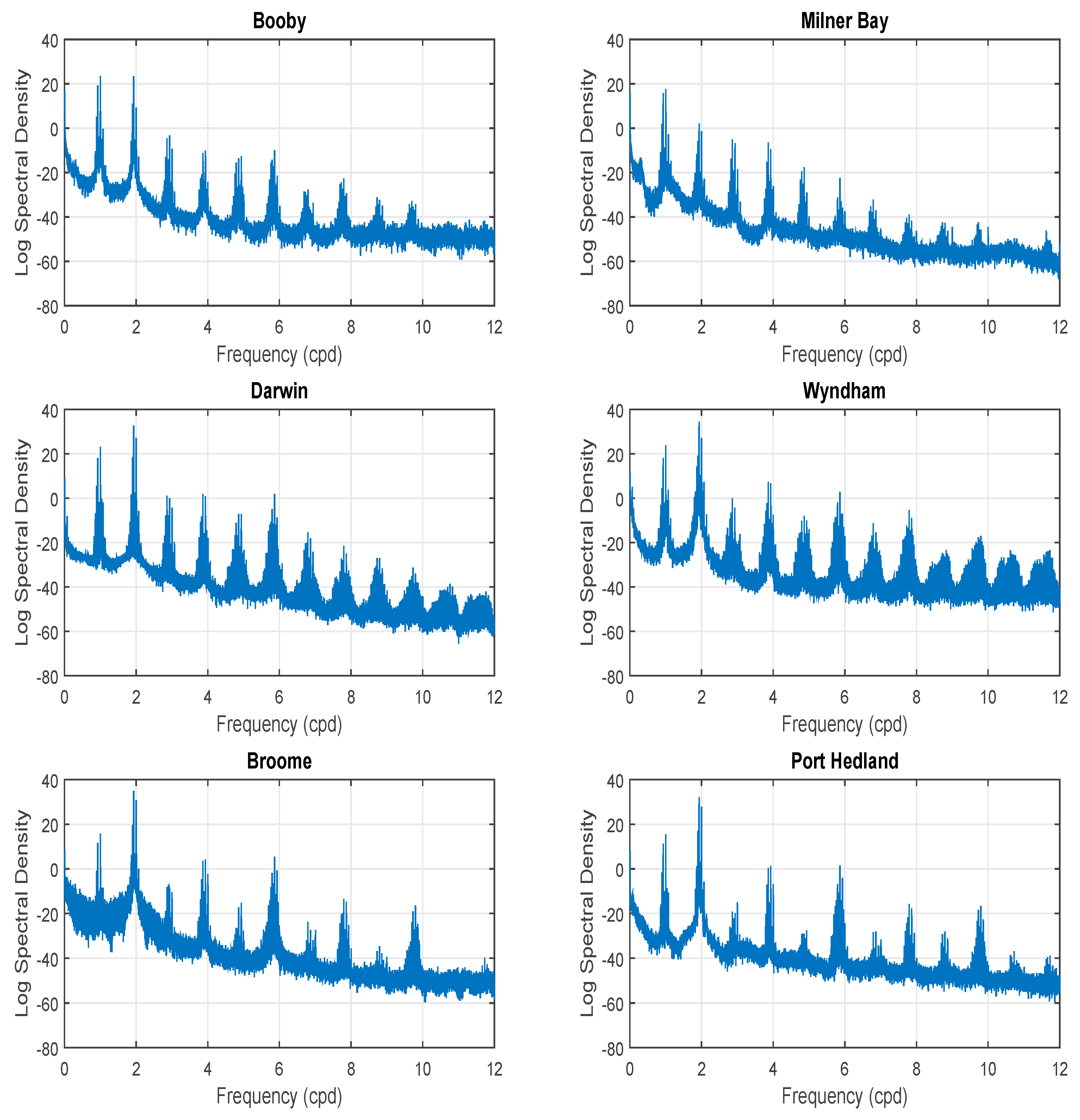
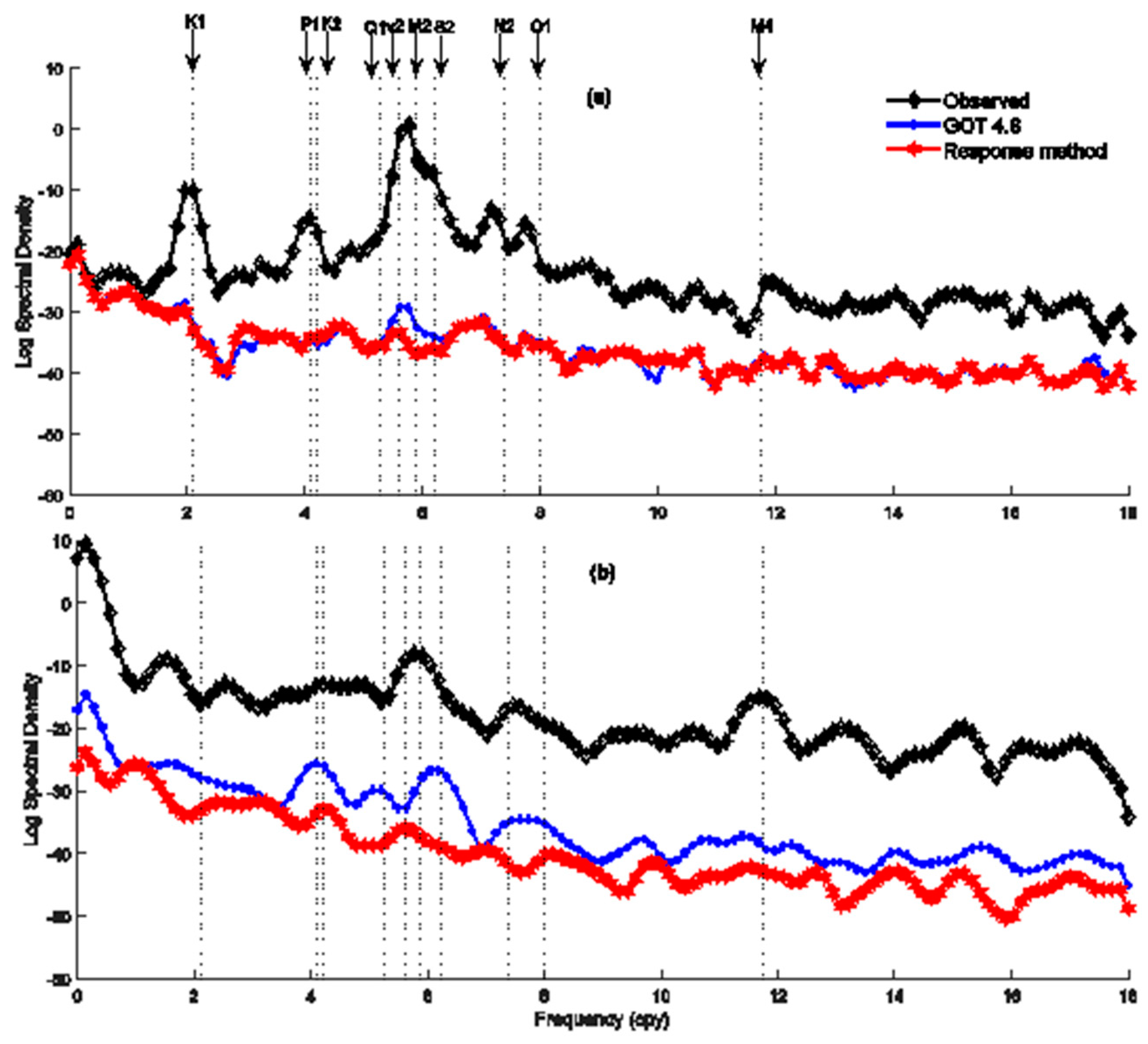
| Tide | Period (Hours) | Aliasing Period (Days) | Aliasing Frequency (cpy) |
|---|---|---|---|
| O1 | 25.819 | 45.71 | 7.99 |
| P1 | 24.066 | 88.92 | 4.11 |
| K1 | 23.935 | 173.32 | 2.11 |
| N2 | 12.658 | 49.55 | 7.38 |
| υ2 | 12.626 | 65.25 | 5.60 |
| M2 | 12.421 | 62.08 | 5.88 |
| S2 | 12.000 | 58.77 | 6.22 |
| K2 | 11.967 | 86.66 | 4.22 |
| M4 | 6.210 | 31.05 | 11.76 |
| M6 | 4.140 | 20.69 | 17.64 |
| MK3 | 8.177 | 96.83 | 3.8 |
| MK4 | 6.088 | 219.60 | 1.66 |
| MS4 | 6.103 | 1083.94 | 0.33 |
| Station Name | Maximum Peaks From Tide Gauge Data | Maximum Peaks from Nearest Altimetry Data | Dominant Tidal Components |
|---|---|---|---|
| Shute Harbour | M2, S2, υ2 | M2, S2, υ2 | Semidiurnal |
| Milner Bay | K1, O1, P1 | K1, O1, P1 | Diurnal and compound |
| Broome | M2, S2, υ2 | M2, S2, υ2 | Semidiurnal |
| Port Vila | M2, K1, S2 | M2, K1, S2 | Diurnal and semidiurnal |
© 2020 by the authors. Licensee MDPI, Basel, Switzerland. This article is an open access article distributed under the terms and conditions of the Creative Commons Attribution (CC BY) license (http://creativecommons.org/licenses/by/4.0/).
Share and Cite
Gharineiat, Z.; Deng, X. Spectral Analysis of Satellite Altimeter and Tide Gauge Data around the Northern Australian Coast. Remote Sens. 2020, 12, 161. https://doi.org/10.3390/rs12010161
Gharineiat Z, Deng X. Spectral Analysis of Satellite Altimeter and Tide Gauge Data around the Northern Australian Coast. Remote Sensing. 2020; 12(1):161. https://doi.org/10.3390/rs12010161
Chicago/Turabian StyleGharineiat, Zahra, and Xiaoli Deng. 2020. "Spectral Analysis of Satellite Altimeter and Tide Gauge Data around the Northern Australian Coast" Remote Sensing 12, no. 1: 161. https://doi.org/10.3390/rs12010161
APA StyleGharineiat, Z., & Deng, X. (2020). Spectral Analysis of Satellite Altimeter and Tide Gauge Data around the Northern Australian Coast. Remote Sensing, 12(1), 161. https://doi.org/10.3390/rs12010161




